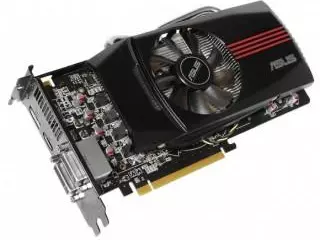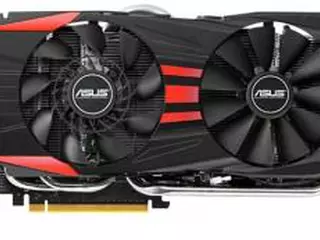Radeon HD 6850 vs Radeon R9 280
In this comparison between Radeon HD 6850 and Radeon R9 280 you will find out which graphics card performs better in today's games. Bear in mind that third-party versions may have more efficient cooling and higher clock speeds. This will increase cards' performance, though not by much. In addition to raw power you should also take into account the dimensions. Thicker models simply will not fit into a small mini-ITX case. The resolution of your monitor also affects the choice, since 4K gameplay requires a more powerful GPU. And don't overspend on the graphics card. Other parts of your build may also need to be upgraded, save some money for the CPU or power supply. For some people Radeon HD 6850 will be the best choice, for others Radeon R9 280 will be their preference. Study the comparison tables below and make your choice.
Main Specs
Radeon HD 6850
Radeon R9 280
Power consumption (TDP)
127 Watt
200 Watt
Interface
PCIe 2.0 x16
PCIe 3.0 x16
Supplementary power connectors
1x 6-pin
1 x 6-pin + 1 x 8-pin
Memory type
GDDR5
GDDR5
Maximum RAM amount
1 GB
3 GB
Display Connectors
2x DVI, 1x HDMI, 2x mini-DisplayPort
2x DVI, 1x HDMI, 2x mini-DisplayPort
Check Price
Check Price
Radeon R9 280 has 57% more power consumption, than Radeon HD 6850.
Radeon HD 6850 is connected by PCIe 2.0 x16, and Radeon R9 280 uses PCIe 3.0 x16 interface.
Radeon R9 280 has 2 GB more memory, than Radeon HD 6850.
Both cards are used in Desktops.
Radeon HD 6850 is build with TeraScale 2 architecture, and Radeon R9 280 - with GCN 1.0.
Radeon HD 6850 is manufactured by 40 nm process technology, and Radeon R9 280 - by 28 nm process technology.
Radeon R9 280 is 77 mm longer, than Radeon HD 6850.
Game benchmarks
Assassin's Creed Odyssey
Battlefield 5
Call of Duty: Warzone
Counter-Strike: Global Offensive
Cyberpunk 2077
Dota 2
Far Cry 5
Fortnite
Forza Horizon 4
Grand Theft Auto V
Metro Exodus
Minecraft
PLAYERUNKNOWN'S BATTLEGROUNDS
Red Dead Redemption 2
The Witcher 3: Wild Hunt
World of Tanks
high / 1080p
9−10
35−40
ultra / 1080p
5−6
21−24
QHD / 1440p
0−1
16−18
4K / 2160p
−
10−11
low / 720p
21−24
60−65
medium / 1080p
12−14
40−45
The average gaming FPS of Radeon R9 280 in Assassin's Creed Odyssey is 241% more, than Radeon HD 6850.
high / 1080p
16−18
55−60
ultra / 1080p
14−16
45−50
QHD / 1440p
0−1
35−40
4K / 2160p
−
18−20
low / 720p
35−40
100−110
medium / 1080p
16−18
60−65
The average gaming FPS of Radeon R9 280 in Battlefield 5 is 223% more, than Radeon HD 6850.
low / 768p
45−50
50−55
QHD / 1440p
0−1
0−1
The average gaming FPS of Radeon R9 280 in Call of Duty: Warzone is 10% more, than Radeon HD 6850.
low / 768p
160−170
250−260
medium / 768p
130−140
220−230
ultra / 1080p
70−75
180−190
QHD / 1440p
40−45
110−120
4K / 2160p
30−33
70−75
high / 768p
100−110
210−220
The average gaming FPS of Radeon R9 280 in Counter-Strike: Global Offensive is 94% more, than Radeon HD 6850.
low / 768p
55−60
60−65
ultra / 1080p
27−30
−
medium / 1080p
45−50
55−60
The average gaming FPS of Radeon R9 280 in Cyberpunk 2077 is 15% more, than Radeon HD 6850.
low / 768p
90−95
120−130
medium / 768p
70−75
110−120
ultra / 1080p
45−50
100−110
The average gaming FPS of Radeon R9 280 in Dota 2 is 64% more, than Radeon HD 6850.
high / 1080p
10−12
45−50
ultra / 1080p
10−11
40−45
QHD / 1440p
−
27−30
4K / 2160p
4−5
14−16
low / 720p
24−27
80−85
medium / 1080p
12−14
45−50
The average gaming FPS of Radeon R9 280 in Far Cry 5 is 291% more, than Radeon HD 6850.
high / 1080p
18−20
60−65
ultra / 1080p
12−14
45−50
QHD / 1440p
−
27−30
4K / 2160p
−
27−30
low / 720p
75−80
180−190
medium / 1080p
30−35
110−120
The average gaming FPS of Radeon R9 280 in Fortnite is 191% more, than Radeon HD 6850.
high / 1080p
16−18
60−65
ultra / 1080p
14−16
45−50
QHD / 1440p
4−5
30−35
4K / 2160p
−
24−27
low / 720p
35−40
100−110
medium / 1080p
18−20
65−70
The average gaming FPS of Radeon R9 280 in Forza Horizon 4 is 250% more, than Radeon HD 6850.
low / 768p
65−70
140−150
medium / 768p
55−60
120−130
high / 1080p
18−20
70−75
ultra / 1080p
8−9
30−35
QHD / 1440p
0−1
21−24
The average gaming FPS of Radeon R9 280 in Grand Theft Auto V is 144% more, than Radeon HD 6850.
high / 1080p
6−7
24−27
ultra / 1080p
4−5
20−22
QHD / 1440p
−
16−18
4K / 2160p
1−2
8−9
low / 720p
18−20
65−70
medium / 1080p
8−9
30−35
The average gaming FPS of Radeon R9 280 in Metro Exodus is 287% more, than Radeon HD 6850.
low / 768p
100−110
130−140
ultra / 1080p
90−95
−
medium / 1080p
95−100
120−130
The average gaming FPS of Radeon R9 280 in Minecraft is 28% more, than Radeon HD 6850.
high / 1080p
18−20
−
ultra / 1080p
14−16
14−16
low / 720p
40−45
100−110
medium / 1080p
20−22
18−20
The average gaming FPS of Radeon R9 280 in PLAYERUNKNOWN'S BATTLEGROUNDS is 76% more, than Radeon HD 6850.
high / 1080p
12−14
24−27
ultra / 1080p
8−9
16−18
QHD / 1440p
0−1
10−11
4K / 2160p
−
7−8
low / 720p
18−20
65−70
medium / 1080p
12−14
35−40
The average gaming FPS of Radeon R9 280 in Red Dead Redemption 2 is 176% more, than Radeon HD 6850.
low / 768p
35−40
130−140
medium / 768p
21−24
85−90
high / 1080p
12−14
45−50
ultra / 1080p
8−9
24−27
4K / 2160p
7−8
16−18
The average gaming FPS of Radeon R9 280 in The Witcher 3: Wild Hunt is 264% more, than Radeon HD 6850.
low / 768p
90−95
90−95
medium / 768p
50−55
60−65
ultra / 1080p
24−27
50−55
high / 768p
40−45
60−65
The average gaming FPS of Radeon R9 280 in World of Tanks is 26% more, than Radeon HD 6850.
Full Specs
Radeon HD 6850
Radeon R9 280
Architecture
TeraScale 2
GCN 1.0
Code name
Barts
Tahiti
Type
Desktop
Desktop
Release date
21 October 2010
4 March 2014
Pipelines
960
1792
Boost Clock
933 MHz
Transistor count
1,700 million
4,313 million
Manufacturing process technology
40 nm
28 nm
Texture fill rate
37.20
104.5
Floating-point performance
1,488.0 gflops
3,344 gflops
Length
198 mm
275 mm
Memory bus width
256 Bit
384 Bit
Memory clock speed
1250 MHz
Memory bandwidth
128.0 GB/s
240 GB/s
Shader Model
5.0
5.1
OpenGL
4.4
4.6
OpenCL
1.2
1.2
Vulkan
+
FreeSync
+
Bus support
AGP
PCIe 3.0
HDMI
+
Bitcoin / BTC (SHA256)
139 Mh/s
408 Mh/s
Eyefinity
+
+
HD3D
+
TrueAudio
+
Design
reference
reference
CrossFire
+
+
DDMA audio
+
Ethereum / ETH (DaggerHashimoto)
21.5 Mh/s
LiquidVR
+
TressFX
+
UVD
+
Check Price
Check Price

